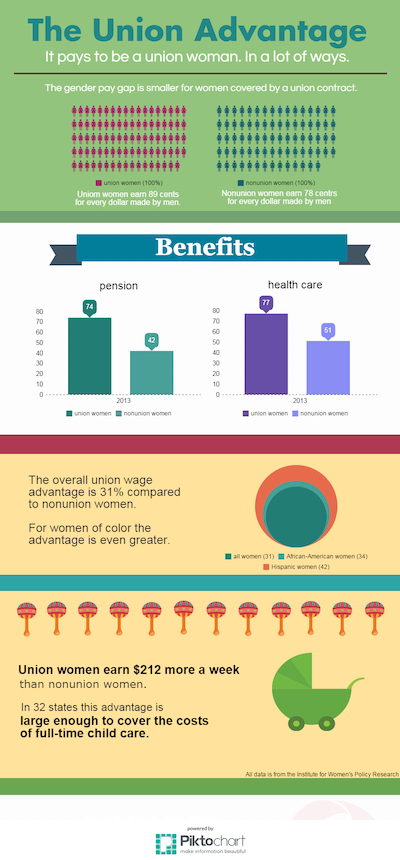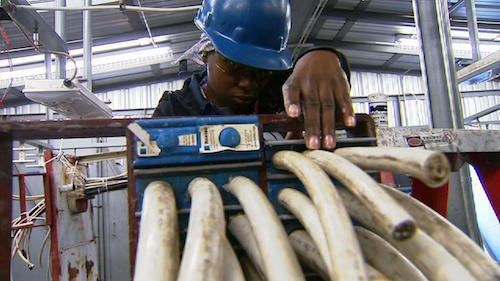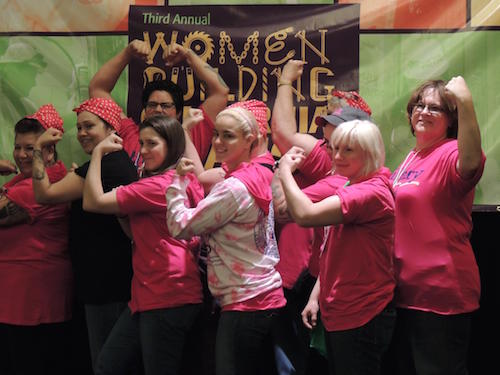It’s not every day that AFL-CIO Secretary-Treasurer Liz
Shuler and newly elected House Speaker Rep.
Paul Ryan agree. But both have spoken recently about the importance of work-family
balance. What only Secretary-Treasurer Shuler understands however, is that
unions are among the best places to actually get that, along with higher pay
and a host of other benefits.


|
| It pays to be in a union, especially if you are a woman, says a new report from the Institute for Women’s Policy Research. |
In his new high-level job, Ryan is in a position to dictate the terms and conditions of his day-to-day duties. In fact, he demanded that he be required to travel less and have time to spend with this family. “I cannot, and I will not, give up my family time,” he said.
But most rank-and-file working people do not have this ability. As Shuler said in an op-ed for the New Republic, “Even as we celebrate the advancement of women in the workforce, the harsh reality is that too many of us continue to struggle when we shouldn’t have to. … Women have a greater share of responsibility at home but, if we don’t have the benefit of a union, are unlikely to have earned sick leave or paid family leave.”
The Institute for Women’s Policy Research recently issued a paper on just how much better union women have it compared to nonunion women. In all states and in all major occupations, union women fare better.
“This research shows that it pays to be in a union, especially if you are a woman,” said Institute President Heidi Hartman. “Not only do union women experience a much narrower gender wage gap with men than women overall, they also earn hundreds of dollars more per week than nonunion women, with greater access to critical benefits that can ensure their long-term financial security and well-being.”
Considering the intractability of the gender pay gap, this is something women can do now to improve their situation. The Institute estimated women won’t achieve pay equity with men until 2059.
The Institute also recently found that the gender pay gap is smaller for women in unions than it is for their nonunion counterparts. For all women, the gap calculates to women earning 78 cents for every dollar made by men. For women in unions, the gap shrinks to 89. And more money means more financial security.
“I have a lifestyle that my friends who aren’t in unions do not,” said Donna Hammond, business representative for Portland, Ore., Local 48. “And they are glad I have a union job so I can provide a cushion. Basically, I’m the safety net.”
The difference in pay can even be enough to cover the costs of childcare, and considering how exorbitant the price tag can be, that is anything but insubstantial.
When looking at the union advantage by occupation, the largest difference was found in the “natural resources, construction and maintenance” category – union women make almost double what nonunion women do.
The Institute researchers also looked at the effects of right-to-work laws. Not surprisingly, the share of union women is higher in states without such laws.
The Institute also reports that women in unions are more likely to participate in a pension plan and receive health benefits through their employer.
For women of color, the difference in income and benefits is even more significant. While the union wage advantage for all women is an increase of 31 percent, for African-American women it’s 34. For Hispanic women, it jumps to 42 percent. African-American and Hispanic union women are also more likely to have health care coverage and pensions.
“It makes my life less stressful and happier. I can go to the doctor and not worry about a huge co-pay,” said Georgette Carrillo, a customer service representative for PG&E and member of Vacaville, Calif., Local 1245.
With the average woman losing $530,000 over the course of her lifetime to the gender pay gap, union membership can be the difference between living above or below the poverty line. For college-educated women, the loss jumps to $800,000. And that’s assuming she can find a job.
Carrillo has a bachelor’s degree in human resources and initially couldn’t find work when she graduated. When she finally did, it paid poorly and came with mediocre benefits.
“They kept saying we’d get a raise, but we never did,” said Carrillo of her nonunion job. “Now, with the union, we always get raises.”
Bargaining for Work-Life Balance
Both the Institute and the Center for Economic and Policy Research have reported that women’s share of union membership is on the rise, and they are expected to be more than half the union workforce by 2025. This may explain some recent trends in family-friendly issues being championed by labor unions and workers’ rights groups like paid sick days and leave – benefits that help everyone.
California has offered paid leave since 2004. The state reported that, along with there being no harm to businesses, there has been a 411 percent increase in men taking advantage of the benefit. On the East Coast, members of the District of Columbia city council recently introduced legislation to give residents 16 weeks of paid leave, which would be the most generous in the nation.
 |
| The union wage advantage benefits all women, with an average increase of 31 percent. For African-American women, it rises to 34 percent. For Hispanic women, it jumps to 42. |
“Issues like paid leave, discrimination and childcare benefits aren’t just ‘women’s issues,’ they’re human rights and working family issues,” said Carolyn J. Williams, IBEW’s director of civic and community engagement. “As such, many of our locals are taking a look at their policies and how they impact their members.”
Williams also said that a number of locals have implemented childcare programs for union meetings.
In addition, the transparency in wages that unions provide likely helps to alleviate pay discrimination. Many people working in nonunion jobs are discouraged if not blatantly disallowed from discussing issues like salary, exacerbating any pay disparity. An increasing number of union contracts have nondiscrimination clauses included.
The statistics cited in the reports from the Institute and the Center apply to the current American workforce, but the benefits of union membership for women are felt among our Canadian sisters as well.
When Kelly Kienleitner decided to switch careers, she knew that as a single mom her salary would have to be large enough to provide for her and her son. So she looked at the building trades.
“Money may not buy happiness, but it can buy you freedom from worry,” said Kienleitner, now chief instructor for the Electrical Joint Training Committee in Vancouver, British Columbia.
Not only was she able to get off welfare and support herself and her son, she excelled as a winder. Kienleitner was the first woman to earn a double Red Seal certification as a motor winder in all of Canada. The Red Seal is a certification that allows the holder to work throughout the provinces.
While women are on track to be the majority of union members, they still comprise a relatively small percentage of those in the building trades. And obstacles still exist, though they are diminishing.
When Kienleitner first started out about 30 years ago, she encountered sexism on the job. But she also received support from others, particularly her union brothers. Having worked at both an open shop and a unionized one, she experienced firsthand the difference it made in terms of how she was treated.
“I would not have made it through my apprenticeship if it wasn’t for my brothers,” said Kienleitner. “That I know.”
Carrillo and Kienleitner both said they received support and encouragement from supportive business managers and others in leadership. Now they are taking on leadership roles and helping newer members thrive.
“Young women are realizing that the trades are an intelligent choice,” Kienleitner said.
Empowering Women
These numbers paint a picture in which women are better off and in measurable ways. What they don’t get at is something Lorretta Johnson of the American Federation of Teachers said in an op-ed for Ebony, “Yes, it [a pay raise] helped me provide for my family, but it also helped me realize my own power, as a person of color, as a woman and, yes, as a trade unionist.”
 |
| Women are expected to comprise half the union workforce by 2025, which may explain the push for work-life balance issues like paid leave. |
Hammond, Carrillo and Kienleitner share this sentiment.
“I didn’t know I was capable of all that I’m doing,” said Carrillo, who is on the national advisory council for RENEW, an initiative to engage the next generation of IBEW members, representing the 9th District. “It gave me the confidence to do so much.”
Carrillo is also an organizing steward and active in local politics, including a successful campaign to prevent the Fresno sanitation system from being privatized.
“No one thought we would win,” Carrillo said. “But we did. We worked with other locals and saved 100 working people from reduced pay and job insecurity.”
Carrillo expressed an interest in getting more involved very early on and was fortunate to have a business manager who encouraged her. This support from leadership is one of four elements that Williams says is needed to get more women in leadership positions. The others are women’s committees, conferences and mentoring.
“We need women talking to women, and it needs to be diverse so they know the union is open to everyone,” Hammond said.
This works when organizing as well. Williams noted how studies have shown that campaigns geared toward organizing women are most successful when the organizer is also a woman.
In addition to mentorship, Carrillo recommends going to high schools. “Not everyone wants to go to college,” Carrillo said. “I didn’t know there were opportunities like this when I was in school.”
With women becoming the majority of union members in the next 10 years, it pays to empower them and encourage their leadership. And as members know, when unions are strong, everyone does well. That’s what our sisters want too.
“I don’t just want good wages and benefits for me, I want them for everyone,” Carrillo said.